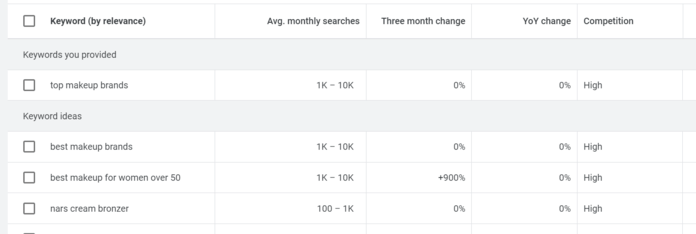Long-tail vs. short-tail keywords
Short-tail keywords are more general search queries usually consisting of one to two words that contain a higher search volume and competition, while long-tail keywords are much more specific search queries that are several words long that have much less competition in the search results.
Your search engine optimization (SEO) strategy can’t ignore long-tail vs. short-tail keywords. Short-tail and long-tail keywords shape your keyword targeting by focusing your efforts on broader or narrow intents, which impacts your rankings, traffic, and even conversions.
Learn more about the difference between long-tail and short-tail keywords now!
What is the difference between long-tail vs. short-tail keywords?
The difference between long-tail vs. short-tail keywords is length, search volume, and competitiveness, with long-tail keywords having more words but less search volume and competitiveness than short-tail keywords, which are one to two words.
Which is better, long-tail or short-tail keywords?
Long-tail keywords are typically better than short-tail keywords. While long-tail keywords have a lower search volume than short-tail keywords, they have a more defined search intent, which makes them easier to target and more effective at attracting your target audience.
Why are long-tail keywords better than short-tail keywords?
Long-tail keywords are better than short-tail keywords for a few reasons, including the following:
- Relevancy: There is a difference between “amusement parks” and “amusement parks southern california.” When you target long-tail keywords, you become more relevant to users searching online and focus your efforts on qualified users vs. all users.
- Volume: Long-tail keywords have a lower search volume than short-tail keywords, but there are more long-tail keywords than short-tail keywords available to target. That’s why leaning into long-tail keywords can benefit your long-term SEO strategy.
- Ease: Compared to short-tail keywords, long-tail keywords are easier to target. Besides having a more definitive search intent, long-tail keywords are also less competitive, which makes ranking for them and capturing their traffic easier.
- Effectiveness: Long-tail keywords are also effective because of their targeted search intent. They attract your target audience, which helps you bring qualified traffic to your site that your team can convert into raving fans.
While short-tail keywords have their use cases (like for extremely authoritative sites and branded keywords), you’ll often see more SEO benefits from focusing your keyword targeting strategy on long-tail keywords.
The basics of long-tail keywords
Learn the basics of long-tail keywords below:
What are long-tail keywords?
Long-tail keywords are keywords that contain at least three or more words, like “amusement park southern california.” Because of their length, they typically have a more refined search intent but also lower search volume and competition levels.
What are examples of long-tail keywords?
Some examples of long-tail keywords include:
- Top of the funnel long-tail keywords
- “best budget travel destinations in europe”
- “tech gadgets for remote work productivity”
- “healthy vegan recipes for dinner”
- Middle of the funnel long-tail keywords
- “home workout routines without equipment”
- “fashion trends for winter 2023”
- “beginners guide to astrophotography”
- Bottom of the funnel long-tail keywords
- “child-friendly restaurants in new york”
- “emergency plumber los angeles”
- “walt disney world tickets discount”
- “heavy equipment rental in philadelphia”
When should I use long-tail keywords?
Except for your organization’s branded terms, you should target long-tail keywords. Even though they have fewer searches, long-tail keywords are incredibly effective at reaching your target audience because of their specific intent.
Cut Your SEO Time in Half
with your new favorite user-friendly SEO tool!
How do I find long-tail keywords?
You can find long-tail keywords in a few ways, including the following:
Internal feedback
Feedback from your internal teams, from sales to customer support, can help you surface long-tail keyword ideas. For example, your sales team could share common questions during the pitch process, while your customer support team could highlight common issues during ticket resolution.
Google Search
Google Search is another free way to find long-tail keywords, like through:
- Autocomplete: Start typing a search, and Google will try to complete your thought. While more time-intensive, this tool can help uncover long-tail keywords related to a short-tail keyword by offering suggestions.
- People also ask: See what questions people ask related to your search. People also ask is an excellent resource for investigating search intent or discovering new, standalone keywords your site could target.
- Related searches: View searches related to yours at the bottom of Google search results. You can use this tool by searching for short or long-tail keywords to get keyword ideas for more refined searches.
While Google Search is one way to find keywords, it’s not the most effective time-wise.
Google Trends

With Google Trends (another free keyword research) tool, you can research long-tail keywords by:
- Viewing trending topics
- Comparing keywords and their trends over time
- Browsing related topics
If you use a paid keyword tool, like Keywords Everywhere, you can see keyword metrics like search volume and competitiveness within Google Trends. While optional, this data can help you skim your keyword results faster.
Master Google Trends
Learn how to use Google Trends for SEO from our award-winning team.
Google Keyword Planner

Google Keyword Planner is another answer for how to find long-tail keywords.
With Google Keyword Planner, you can enter a topic, and Google Keyword Planner will generate dozens of related keyword options. Plus, it’ll include keyword metric data like search volume and cost per click (CPC), which you can use to evaluate the keywords.
It’s important to note that Google Keyword Planner is intended for Google Ads, so you’ll find its keyword data focuses on more transactional terms since those are the types of searches advertisers bid on the most.
If you’re looking for Google Keyword Planner alternatives, tools like SEMrush, Ahrefs, and KeywordTool.io offer similar functionalities for keyword research.
Paid keyword research tool
Besides the free options above, you can use paid keyword research software like Ahrefs or Semrush. These tools have built-in keyword research toolkits that allow you to enter a seed keyword and then narrow your results through filters for search volume, number of words, competition score, and more.
The basics of short-tail keywords
Learn the basics of short-tail keywords below:
What are short-tail keywords?
Short-tail keywords are keywords that contain one to two words, like “travel destinations.” Because of their length, they typically have a broader search intent but also higher search volume and competitiveness.
What are examples of short-tail keywords?
Some examples of short-tail keywords include:
- Top of the funnel short-tail keywords
- “travel destinations”
- “vegan recipes”
- “tech gadgets”
- Middle of the funnel short-tail keywords
- “workout routines”
- “fashion trends”
- “astrophotography guide”
- Bottom of the funnel short-tail keywords
- “child-friendly restaurants”
- “emergency plumber”
- “walt disney”
When should I use short-tail keywords?
Consider using short-tail keywords when you have a highly authoritative domain or want to target your company’s branded keywords. You’ll usually start targeting short-tail keywords for branded terms vs. non-branded short-tail keywords.
How do I find short-tail keywords?
You can find short-tail keywords with the same strategies for long-tail keywords:
- Google Search
- Google Trends
- Google Keyword Planner
- Paid keyword research tools
When using these tools, you’ll often start with branded search terms. As your site becomes more authoritative, you can expand and start researching short-tail keywords, which will contain only a few words.
Grow your knowledge of short-tail and long-tail keywords
Congrats, you’ve learned about the difference between short-tail and long-tail keywords! If you want to learn more about keyword targeting, visit the SEO.com blog or check out our SEO glossary.
P.S. For discovering keyword opportunities even faster, check out the SEO.com app!
Cut Your SEO Time in Half
with your new favorite user-friendly SEO tool!
Table of Contents
- What is the Difference Between Long-tail vs. Short-tail Keywords?
- Which is Better, Long-tail or Short-tail Keywords?
- Why Are Long-tail Keywords Better Than Short-tail Keywords?
- The Basics of Long-tail Keywords
- The Basics of Short-tail Keywords
- Grow Your Knowledge of Short-tail and Long-tail Keywords

Cut Your SEO Time in Half
Track rankings, analyze competitors, and audit your content faster with SEO.com.
Writers

Related Resources
- Share of Voice: Definitions, Calculations, and Importance
- What Are Backlinks? Definition, Tips, and More
- What Are Breadcrumbs? Definition and How to Use Them
- What Are Featured Snippets?
- What Are KPIS and Why Do They Matter?
- What Are Meta Keywords and Should I Use Them?
- What is a 301 Redirect? When & How to Use Them
- What is a 302 Redirect? Comparing 302 vs. 301 Redirects
- What is a 404 Error? Overview and How to Fix It
- What is a SERP (Search Engine Results Page)?


